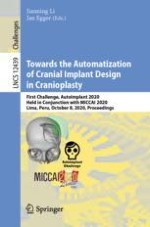2020 | OriginalPaper | Buchkapitel
Automated Virtual Reconstruction of Large Skull Defects using Statistical Shape Models and Generative Adversarial Networks
verfasst von : Pedro Pimentel, Angelika Szengel, Moritz Ehlke, Hans Lamecker, Stefan Zachow, Laura Estacio, Christian Doenitz, Heiko Ramm
Erschienen in: Towards the Automatization of Cranial Implant Design in Cranioplasty
Aktivieren Sie unsere intelligente Suche, um passende Fachinhalte oder Patente zu finden.
Wählen Sie Textabschnitte aus um mit Künstlicher Intelligenz passenden Patente zu finden. powered by
Markieren Sie Textabschnitte, um KI-gestützt weitere passende Inhalte zu finden. powered by
